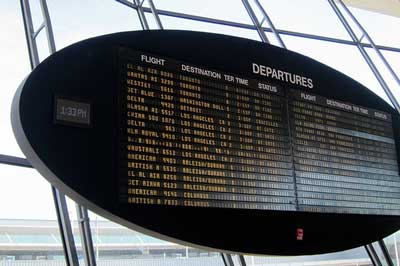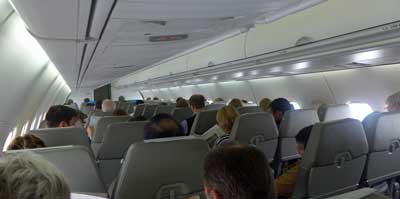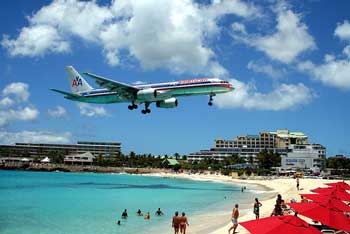Flights are cheapest 5 to 16 weeks out in 2019: Here’s when to book
Trying to find the absolute cheapest airfare for a trip you are planning is like playing a game that feels too easy to lose. Now in this era of ‘big data’ where many companies are able to check airfares on every route every day to calculate the cheapest possible time to buy, it’s finally a bit easier.
Only a few years ago the advice was often to buy between 4 and 6 weeks out, but things have changed and it really depends on where you are going. As you’ll see in the 2019 update below, the window for buying the cheapest fares starts earlier these days and buying about 4 months out often leads to the best deals. We’ve summarized a variety of studies below and with a quick scan you should be able to get some insight on when to buy and when to wait.
Note: This article was first published in 2012, and has been updated and revised each year as new information has come out, most recently in February, 2019.
2019 UPDATE: The data for 2018 has been similar to 2016 and 2017, but it's still complicated
As of 2019 there are quite a few different companies that are analyzing millions of airfare purchases in order to find the money-saving trends. They tend to show the same pattern, which is that buying two or four months early is the sweet spot for most tickets.
For the tests we ran below we used the very helpful tool from Cheapair.com.
Summary: Buying air tickets earlier will usually save you money
In years past the sweet spot for buying cheap tickets often didn’t start until 6 to 8 weeks before the flight, but the data from 2018 shows once again that the cheaper airfares are now usually available starting 4 to 6 months out in many cases. In other words, if you are sure you want to fly on particular dates, you can usually get something close to the lowest possible fare if you book almost half a year out.
Another interesting thing about the data is that once you reach the beginning of that “sweet spot” where fares are near their low for any given flight, they still bounce around by up to US$50 over the next couple of months before they start heading higher as the flight approaches. So the best strategy is to set an alert for fare decreases on the route that you are shopping for, and buy as soon as you get one of those dips.
North America to Europe: 7 to 16 weeks out is usually the sweet spot

As long as you are within that 16-week window, the longer you wait the greater the chance that the fares will start jumping up for good. This is especially true for popular travel periods such as July and August. In spring and autumn you can usually get away with waiting a bit longer.
North America to the Caribbean: Book 3 to 12 weeks out

The Caribbean hurricanes in 2017 won’t change anything, in case you were curious. The islands that were affected most are all small islands that only got a small percentage of Caribbean flights in the first place. The busy airports such as Cancun, Punta Cana, and even San Juan, Puerto Rico (which has fully recovered) should carry on the same as before when it comes to airfare windows.
North America to Asia/Pacific: 8 to 20 weeks is cheapest

The good news is that you no longer have to book so far in advance to get something close to the lowest fare. The more obscure your destination (Hanoi, Kathmandu etc), the earlier you should probably book. For more common destinations such as Tokyo, Singapore, and Bangkok, you have more time to wait.
North America to Middle East & Africa: 6 to 12 weeks is best
Another case where flight shoppers in 2019 can wait a bit longer to get a great deal than even a year ago, you should now be able to get a good fare to a place like Dubai, Abu Dhabi, or Cairo only 6 weeks or so out.
North America to South America: 5 to 16 weeks is cheapest
In 2019 there is a wider range for the lowest fares going from North America to South America. Many of these are not especially popular routes so there isn’t much competition on them. In cases like this it’s usually best to book early because if there is only one airline flying that route, you are vulnerable to a nasty surprise.
On short and popular routes, 3 to 4 weeks is usually fine

Flights within Europe: Buy as early as possible
In reality the cheapest fares within Europe are almost all on the low-cost carriers such as Easyjet and RyanAir. If you are flying on any of those airlines, the fares ALWAYS start out cheap and get more expensive as more seats are sold. So the cheapest time to buy on a low-cost airline is NOW (or as soon as tickets go on sale, which is usually 11 months out).
Flying on a low-cost carrier (even to Europe): Buy now

This is even true on Norwegian Airlines between the US and Europe. They offer the lowest fares in general on scores of popular routes, so if you are sure of your dates you should buy the tickets as soon as possible to lock in the lowest fare. They won’t be getting any cheaper.
Cheapest times of the year to fly
The trends above should be valid for flights for most of 2018 and into 2019, but there are a few times of the year that are always a bit cheaper than others. For this information we look to research from Rick Seaney of FareCompare, who has been doing this longer than anyone else.
Domestic US flights are cheapest
January 7 to March 5 (between Christmas Break and Spring Break)
April 18 to June 2 (between Spring Break and Summer travel season)
August 22 to mid December (most summer trips end and autumn is a slower season)
If you can fly in any of the periods mentioned above you are likely to get lower fares than if you fly during the traditionally busier periods.
US to Europe flights are cheapest
Before June and after mid August (summer season is by far the busiest, and it ends earlier than you might think)
Weekdays and especially Tuesdays and Wednesdays (Even more so than domestic travel, trans-Atlantic travelers like to travel Fridays through Sundays, so flying the other days will almost always be cheaper).
Cheapest time to book flights for Christmas and New Year's trips
According to a 2015 study by Skyscanner, the absolute cheapest time to book flights for the popular dates just before Christmas and New Years is August 10 to 16, at least based on their 2014 data. The study also shows that fares only inch up a bit in later August and into September, but that by early November the fares will be closer to their peak.
Previously we’d heard that it’s best to buy holiday flights as early as possible, which is usually 11 months out for most airlines. I think that’s still mostly true, partly because it will allow you to pick the best possible departure times in both directions. But if you aren’t quite so picky as to which time of day you leave and return, waiting until mid August seems like a decent idea and you’ll still get a relatively good fare.
Important exception: Book flights on low-cost airlines as early as possible, always
If you are thinking about booking a flight on a low-cost airline, such as Southwest or Spirit in the US, or EasyJet or Ryanair in Europe, or Air Asia in Asia, the cheapest fare will always be as early as you are ready to commit. Unlike the more traditional airlines, the low-cost carrier revenue model is based on starting with all seats as cheap as they’ll ever be when the flight is officially in the system. Then as seats are sold on that flight, the fare goes up as the plane is selling out. So maybe the first 20% of the seats are sold at the lowest price, and when those are gone, the next 20% are sold at a higher price, and so forth until all seats are sold or the plane takes off.
However, it’s important to consider the fact that “low-cost airlines” aren’t necessarily cheaper than their more traditional counterparts. Specifically, Southwest Airlines will often be more expensive than American or United, at least once the first group of cheap seats is gone. Also, since traditional airlines do in fact lower fares during the sweet spot of a few weeks to a few months before departure, you might find that waiting for those lower fares might be the best deal of all.
Flights are still often cheapest on Tuesdays and Wednesdays

My favorite trick for finding the best fares for an upcoming flight is to check for that route on a Wednesday and returning on a Wednesday. That will almost always show you the lowest possible fare, and then you can compare prices of other days of the week to see how much more you are willing to pay to fly on, say, a Friday or Saturday.
The advice: Check any and every day of the week, and if it’s the weekend you might want to wait a few more days to see if fares drop.
Why do airfares go up and down and up again as the day approaches?
Looking at the data above, you might think the airlines are playing some sort of game with flyers, but these pricing policies are actually a result of elaborate data and computer models that help them make the most money from each plane that leaves the ground. Here’s why:
People who buy plane tickets early are less price sensitive
In the world of economics they call this being “inelastic” in that in some situations consumers will buy almost exactly as many tickets, even if the price is higher. Airlines (obviously) want to maximize their profit for every seat they sell on the plane, so they take advantage of those who are driven to lock in early.
Consumers who buy early might:
- Already have set vacation days they want to use all of
- Be attending an event, such as a wedding, where there’s no flexibility
- Be someone who feels great stress until the ticket is locked in
In the above situations, whether a round-trip between Los Angeles and London is US$800 or US$1100, the person buying at least 3 months out is likely to buy either way. There is little incentive to airlines to sell a ticket for $800 if they’d sell almost as many at $1100.
People who buy plane tickets late are also less price sensitive
Similarly, consumers who are interested in flying 10 or fewer days from any given moment are also inelastic. They are likely to pay a premium for the convenience of going soon, so there’s little incentive for airlines to discount these tickets either.
Consumers who buy at the last minute might:
- Have just gotten approval for fixed time off soon
- Have an event on a fixed date (a football game, etc)
- Be someone who hates to commit to things early, and is willing to pay extra for the added flexibility
Now, keep in mind, that anyone who is hoping to fly in 10 days or fewer from now will see higher prices, and they’ll have the option of going 2 or 3 weeks later to save quite a bit of money. This price discrimination allows airlines to sell more expensive seats to those who can’t wait, and cheaper tickets to those who can.
What happened to cheap “last-minute” fares?

They tend to offer cheap flights between obscure city pairs on the least popular travel dates. So if you are ready to fly between, say, Charlotte and Bermuda this coming Saturday and return the following Tuesday, those last-minute deals could be for you. But for most of us, they never appear for places we really want to go and at times we want to travel.
Why no last-minute deals, you might ask? Why are airlines willing to fly with empty seats instead of filling them for low prices?
The reason airlines don’t lower prices for unsold seats at the last minute is that the last thing they want to do is condition travelers to wait until the last minute, hoping for a bargain, and then sometimes not flying at all when a bargain doesn’t appear.
Think about it. If you wanted to go from Los Angeles to London at some point soon, and a round-trip next month is $900, but if you go in 2 days it’s only $650, you are likely to buy the cheap ticket two days from now, or skip it and hope that the same deal is available next month when you are ready to go.
Airlines make more money on each plane-load of people if they condition passengers into buying earlier at higher prices, or very early at even higher prices.
When to wait for fare sales

If you are waiting for a fare sale and wondering when it might appear, it’s important to consider the airlines’ motivation in announcing them. Let’s say they announced an October fare sale in June, with round-trip fares way lower than those offered in summer. That would actually cannibalize their business for July through September. If someone is considering paying a high fare to fly in August, the airlines are not motivated to show them a much lower fare if they waited. That would lead to empty seats in late summer, which would be very costly for them.
In almost all cases you are best off waiting until 6 weeks or so before your departure date, but it’s also important to track the fares before that, and keep an eye on fare sales.
This same research by the AP also said that fare sales usually appear on Tuesdays and are over by the end of Thursday, so check fares early in the week and if a price drops then jump on it. They also found the highest fares showed up for those searching on Saturdays and Sundays, so you might be best off just skipping the weekends for fare research anyway.

Great thank you & thanks for such impressive response times on this thread!
Roger thank you for this post–really helpful man! Quick question — me and my gf are trying to fly to Belize (leaving from Orlando or South FL) around the 21st of July for my Birthday.
My gf has watched prices jump up a bit in the last week and is officially in the dreaded ‘panic mode’. My question to you—at this point are we better off booking now at the most recent higher prices ($450ish) or bite the bullet and hold out for another week or two in hopes of a deal popping up? I’m pushing for the latter, but not based on anything other than gut. Appreciate your opinion. Thanks again for your time!
Any airline suggestion between SouthWest / AA / United?
Owen,
If you want to fly Southwest then buy ASAP for the lowest prices. For AA or United there is a chance that the fares will go down again. My hunch is the same as yours in that it seems likely prices will drop again. July in Belize is part of the rainy season so it’s not a very busy time there. Also, for the Caribbean the best deals tend to be only two or three weeks out, as long as it’s not one of the peak season periods, which is not. So long story short, it’s a bit of a gamble but I think waiting up to a few more weeks might be worth it, and it seems very unlikely that those planes are really filling up this early. Best of luck with this. -Roger
Thank you so much! This is very helpful! I appreciate that you took the time to answer!
What an informative post! Thank you so much! I am planning on traveling from Japan (where I work) to my home in Maine this summer. I am a teacher, so unfortunately my dates are not very flexible. I need to leave on August 9th and return on the 16th or 17th. I know this is one of the busiest travel seasons in Japan, so I don’t have much hope for a cheap ticket. I’ve been tracking prices over the past couple of weeks, and it looks like $1750 is around the lowest. As we get toward the weekend, I’ve noticed a slight upward climb. So I’m wondering, would it be OK to wait another week or two and hope that the prices might drop mid-week again? My big fear is that all the “good” flights (with short layovers etc.) will get taken, and I’ll be stuck with a terrible flight. How does this work? Do new flights keep dropping, or are all the available flights going to be snatched up? If you have any feedback about this, I’d greatly appreciate it! Thank you!
Nicole,
I’m happy you found this helpful. It’s a shame that the ticket is so expensive, but for popular days in August I’m not surprised. The thing about ticket prices going up on weekends and down on weekdays is very hard to predict and it doesn’t happen on all routes. My best guess is that there is a decent chance the fares will go back down again in the next week or two, but even if they don’t it’s very unlikely that they’ll go up much or at all right now. If you wanted to fly two or three weeks from now you could get an unhappy surprise with the ticket prices going up every few days, but with three months to go the tickets tend to rise slowly and then stay put or come back down, and usually not rise again for a couple weeks. I think it’s worth waiting for another few days at least. Best of luck on this. -Roger
Hi Roger,
I am looking for advice for flying from LAX to Seoul Korea on July 23 returning August 23. Do you think I should wait since I am three months out I sound a couple for around 900, or do you think the prices will continue to go up. I’m not sure what a good price for this time of year is so I’m not really sure when to buy.
2) You said 8 to 20 weeks for Asia trips but, then you said six weeks at the end of your article. is the best option to start looking at 20 weeks out to get the low-fare airlines but then wait to see if the price goes lower for a little while?
Abraham,
Sorry for the confusion in the article. I try to update the article with all the most recent findings, and sometimes they can contradict each other a bit. Right now I’m seeing that on LAX to Seoul the fares tend to be lowest from 5 months out until about 2 months out when they start climbing again. Also, July 23 is still in the peak summer travel season so you can expect to pay at least a bit more than if you went in September or later. And US$900 round-trip looks like a pretty good fare on that route as well. I’d say that there is a small chance that the fare will drop a bit in the next month or so, and a much great chance the fare will start rising and keep going up. In other words, I’d buy soon if I were you. -Roger
I am looking for advice on when to book a flight from LFT to LAS, leaving 12/5/2018 and returning 12/9/2018. Your input is greatly appreciated.
LaLa,
I’m not as familiar with patterns at smaller airports like Lafayette, but I think the advice should be the same as from other US airports. For most domestic flights into Las Vegas the sweet spot starts about 10 or 11 weeks out and the fares usually stay about the same until about two weeks out. Las Vegas is nearly empty in the first half of December so you should be able to get a good deal on the flight as well as a hotel. But again, the fares should come down by September or so and then stay about the same through mid November, so if you are sure you are going to go it’s probably best to buy in late September so you don’t risk losing a great fare. Bon voyage. -Roger
I have a vacation package to Washington DC for September 4 – 7, 2018, and I’ll be flying from the Pensacola Florida area. I have been watching the airfare for a couple of months, thinking it would fall but it has only gone up by about $35 since I started watching in January. You mentioned in your article that Washington DC is a popular area to visit with many flights in and out. Is it likely that airfare for September flights will fall between now (March) and then?
Pat,
Those dates right after Labor Day shouldn’t be too busy, but the problem is that Pensacola and Mobile Airports are so small that there isn’t good public data on them, and I’m less confident about small airports like that when it comes to fare patterns. My best guess is that fares are likely to drop in the next month or two. For a shorter flight like that it’s common that most tickets are sold only one or two months out, so we are confident that the seats aren’t yet filling up. I think I’d wait and there is a good chance of a price drop or maybe it would stay the same. The price rise recently might be due to fuel prices going up. Most of all I think it’s unlikely that the fares will go up much soon and just keep going up from there. Usually you can get about the same fare on a route like this 2 or 3 months out, so I think waiting until then should be pretty safe, and hopefully you’ll get a drop before then. Best of luck on this. -Roger
Great site and well kept up.
We’re travelling from IAD to South Africa late October-November. We’ve decided to blow the wade on this bucket list travel and go business class.
Are there deals to be had with this option, or should I just bite the bullet?
Also, where do you get your data?
Thanks
Peter,
Thank you. The data I have used for the article above comes from a variety of sources, and most recently from the fare tracker that I link to near the top of the article. It is constantly checking fares of flights to, from, and within the USA. There are other sites that deal more with non-US fares, such as skyscanner. All that said, I can’t say that I’m too familiar with fare patterns for business class fares. My understanding has always been that Business Class fares were pretty much fixed at the high prices. As you probably know, many of the people flying Business on some flights are people who used points or miles for an upgrade, and I think sometimes that can even work out cheaper than cash. I don’t believe the Business Class fares drop in price if not many are reserved and the flight is approaching, although I could be wrong. I think the airlines just use them for upgrades to burn points and all that.
You might also look into Premium Economy options, which are more common each year lately. For US domestic flights the Premium Economy is usually just a few more inches of legroom, but on many international flights it can be much closer to Business Class. I flew from LAX to Seoul recently on Singapore Airlines and the Premium Economy was amazing. And I’ve done it on Norwegian Air across the Atlantic a couple of times and it’s also MUCH more luxurious than standard coach, and far cheaper than Business Class. Sorry I couldn’t help more and have a great trip. -Roger
Thank you for answering all the above questions.
My Question: I will be flying from LAX to San Jose, Costa Rica 7/21 and flying back 8/3. When is the best time to buy, should I stick to a major airline, like delta and Alaskan Air, or go with a cheaper airline? If I do wait to buy will my options on time and days be affected? How much of a discount for waiting am I even looking forward to? Making sure the wait is worth it?
Stacey,
It looks like on that route the fares tend to be cheapest from about 10 to 20 weeks out, and right now we are at about 26 weeks out so I would wait. It seems that you could get a good flight for around US$600 round-trip as of now, and I would think you could get something closer to or possibly a bit below US$500 starting in March or April. On the other hand, since you want to go on specific weekend dates, they might not go much lower than they are now. Still, I see almost no risk in waiting at least until March to see what fares are. I can guarantee that those flights are barely booked at all as of now, and there is no reason why fares would just keep going up from here, at least until April or May.
As for which airline, I take those non-US airlines all the time if they offer low enough fares. I would mostly look at convenient flight times and choose that way. The other side to all of this is that it can be stressful to keep checking airfares hoping to see a discount and dreading a fare increase. It looks like US$450 round-trip is as low as they ever get on that route, and they may not offer those fares in summer at all. Best of luck with this. -Roger
Roger,
I certainly appreciate all your great advice. I enjoyed reading through your article and comment exchanges with your impeccable follow through on all questions.
I am planning a vacation from Washington DC to Australia and Hawaii in summer 2018 (5.5 months from now). I have placed some price trackers for the following itinerary on web, but want to get your advice. Is 11 weeks out still a good time to buy for this multi-destination overseas travel, or the sweet spot is somewhere around 19 weeks out? Itinerary is as follows:
June 21, WAS to BNE (firm, Can arrive a day or two earlier)
July 3, BNE to MEL (flexible)
July 6, MEL to SYD (flexible)
July 10,SYD to OGG (firm)
July 18, OGG to WAS (can return a day or two later)
Thank you,
Daniel
Daniel,
It looks like 15 to about 8 weeks out is the sweet spot for flights between the US and Australia. In my own experience it’s easier to get a cheap flight into Sydney, so you might look at that as well because there is so much more competition. For those flights within Australia, if they are on low-cost airlines then the sooner you buy them the cheaper they probably will be. Nearly all low-cost airlines start out with low ticket prices and then raise them as they sell more seats on any given flight. I hope this helps. Let me know if you have any other questions. -Roger